So many responsibilities! So much to do! How can a social media manager do it all? By maintaining a well-balanced schedule.
With so many different social media platforms to manage and such a long to-do list to tackle, you may find knowing where to start and how to plan your day effectively tough.
1. Go Over Your Daily Calendar
Before you start on daily routine tasks, take a look at what’s happening that day.
Look for time-sensitive events like Facebook Lives or Twitter chats, and other tasks that a social manager does.
Think about whether you need time to prepare for them, whether you’re hosting or participating.
Then set up calendar notifications or alarms with plenty of time to spare.
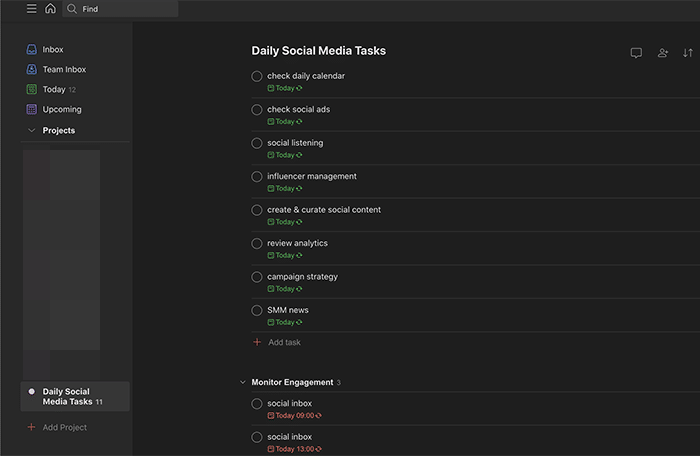
Daily tasks for a social media manager
For example, I use Todoist to schedule events at specific times throughout the day. When I absolutely can’t miss something—like a client call or a livestream—I also set a phone alarm.
Related Post: Social Media Manager Salary: How Much Should You Be Making?
2. Connect With Clients or Colleagues
Next, check your email or messaging apps for important communications from clients or colleagues.
Respond immediately to anything simple—like a meeting request—or anything urgent—like a campaign update. Flag anything else for follow-up.
Then respond within your standard window of time.
For example, I respond to client emails within 24 hours maximum.
Once you’ve done an initial check, close your email and messaging apps.
I stay focused when I check in with clients and colleagues at a few specific times throughout the day rather than constantly respond to new message notifications.
3. Check Paid Social Campaigns
After you’ve reviewed the day’s events and done any essential check-ins, open your social media dashboard.
Start by checking the performance of any paid social campaigns you’re running.
Look for unusual changes in impressions or conversions. Address any minor issues right away. Put any major problems on your to-do list for later.
For example, I monitor comments and make any bid or budget adjustments right away. I save a copy or creative updates and in-depth audience analyses for the afternoon when I usually have fewer distractions.
4. Respond to Engagement and Mentions
Next, make your way through your social inbox.
Start with what looks most important, like reading and reacting to comments on a viral post.
Then read over your mentions and direct messages (DMs). Aim to leave nothing unaddressed.
Instead, respond to each item, assign it to a colleague, or flag it for future follow-up.
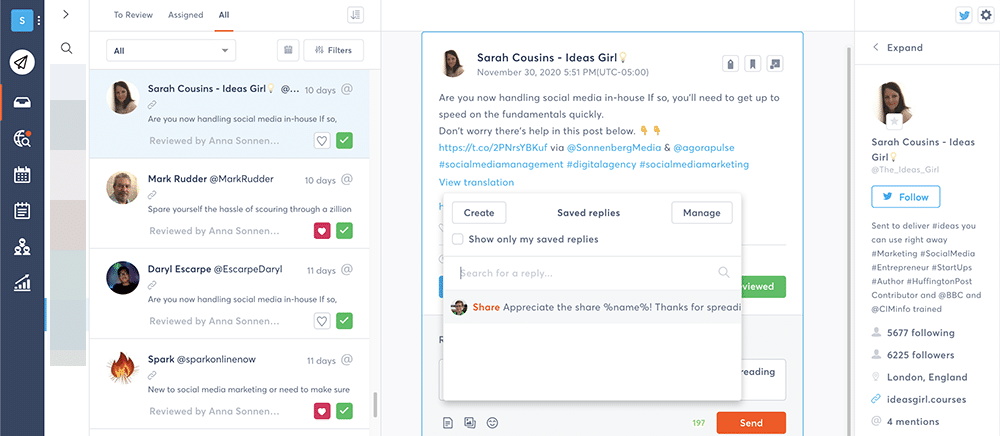
Monitor social media management via a social media management solution
To save time, set up saved replies to send in response to common questions or comments. You can also moderate comments automatically to get through your inbox faster.
For example, I automatically label messages from new leads, so I can respond efficiently.
Pencil in a couple of other times to respond to engagement before the day ends. I generally check social inboxes at set times so notifications don’t distract me throughout the day.
5. Monitor Hashtags
Then open your social listening dashboard and go over the hashtags and keywords you’re tracking.
Start by reviewing branded or campaign hashtags. Respond to or assign important items as necessary.
Then look over industry or competitor hashtags.
Join the conversation or follow relevant accounts.
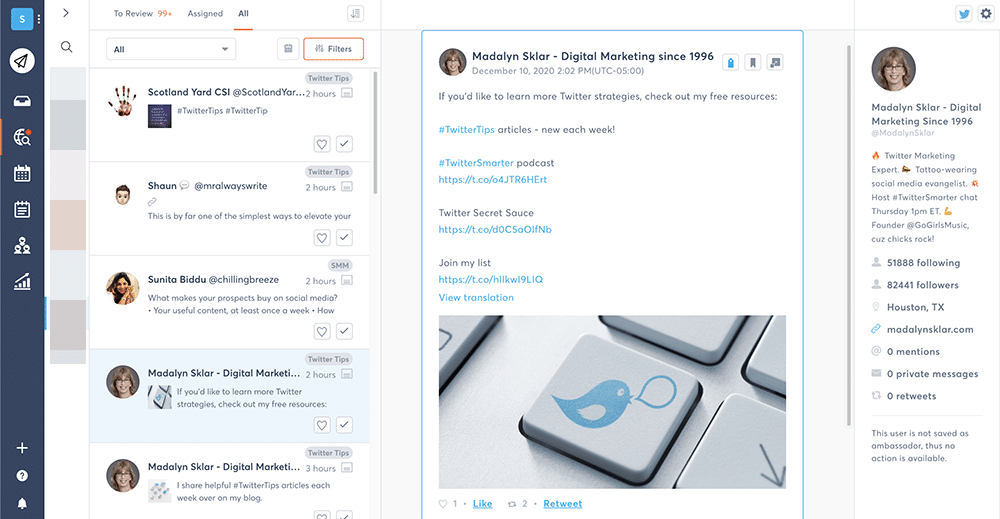
Social listening should be a task for every social media manager.
Make a note to tackle any time-consuming tasks later.
For example, if I identify user-generated content (UGC) to share or trending topics to pursue, I add them to a list of things to explore when I have more time.
6. Follow and Engage With Influencers
Next, check on any influencers you’ve partnered with and engage with their content.
Do the same for influencers you’d like to work with so you, as a social media manager, can start to build a relationship.
Seek out and follow new influencers in your niche, and add any campaign ideas to your to-do list.
7. Review Scheduled Content or Publish Live Posts
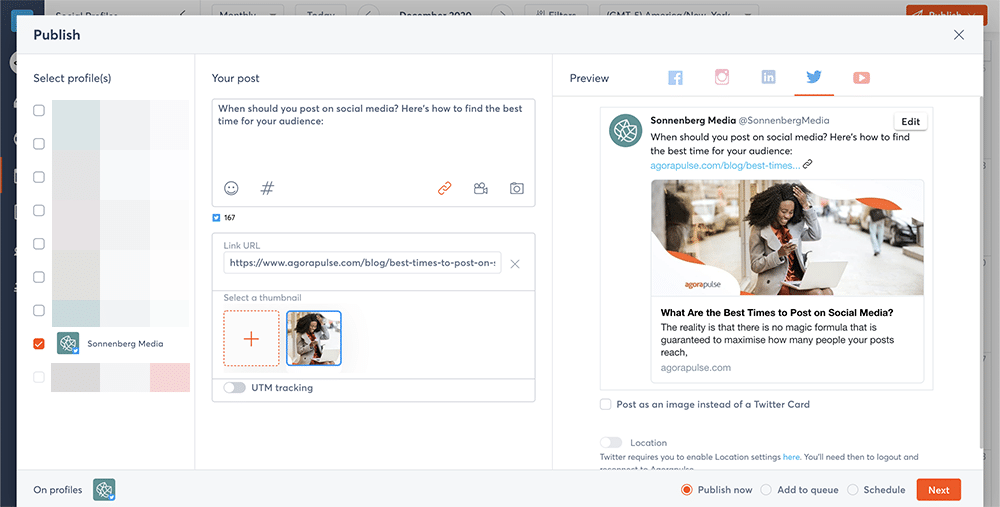
Publish timely social media content.
If you’re scheduling content, check your social media feeds to make sure it goes live as planned.
If you need to publish posts manually or share time-sensitive content, set an alert to do so at the right time in your daily schedule.
Leave plenty of lead time so your clients or colleagues can approve the content as necessary.
8. Create New Content
Once you’ve handled all the urgent tasks on your list, set aside some time to do creative work:
- Write captions or edit brand assets for the next week’s posts.
- Create a script or work out set details for an upcoming livestream.
- Make a shot list and check your prop supplies for the next day’s product photoshoot.
9. Curate & Queue Content
In addition to creating content, you’ll want to dive into content curation as well.
Then select curated content that appeals to your audience and add it to your publishing queue:
- Use tools like BuzzSumo or Quuu to find high-performing content in your niche.
- Review the UGC you saved earlier and add the best examples to your social media schedule.
- Go back to your social listening dashboard and pick out trending topics to research.
Remember to have a variety when posting content.
10. Review Analytics & Optimize Campaigns

Find the best times to post on social media.
You may only prepare social media reports every week or month. But review analytics more frequently is important.
Why wait until the end of the month to resolve a costly problem when you can deal with it much sooner?
- Set aside a few minutes to check over engagement stats and sentiment for recent posts. Identify outliers and address any negative performance issues, especially if you’re in the middle of a big campaign.
- Look for unusual account growth or follower loss. Identify the cause and address any major losses. If you’ve gained more followers than usual, aim to leverage the opportunity.
- Review the best times to post on social media so you can reach followers at the right time. Update your posting schedule or publishing queue as necessary.
11. Develop Strategies
Set aside time for strategic planning.
Look over your annual social media plan, and map out your upcoming campaigns.
Book photo or video shoots, plan a posting schedule, draft content, and get input from stakeholders. Work as far in advance as you can, so you have time for edits and approvals.
Even if your upcoming campaigns are under control, I still recommend taking a few minutes each day to review what’s coming up for your company or clients. I jot down ideas, brainstorm campaign strategies, and look at the big picture so I can help my clients succeed.
12. Read Industry News
To finish out the day, pull up your reading list to scan the headlines and read the big stories.
Start by going over social media news from sources like Social Media Today and Social Media Examiner.
Keep an eye out for major platform updates and new features that might affect your strategy.
Then do the same for news from your company’s or clients’ industry.
Watch for breaking news to share in your publishing queue or trends to explore as you curate content.
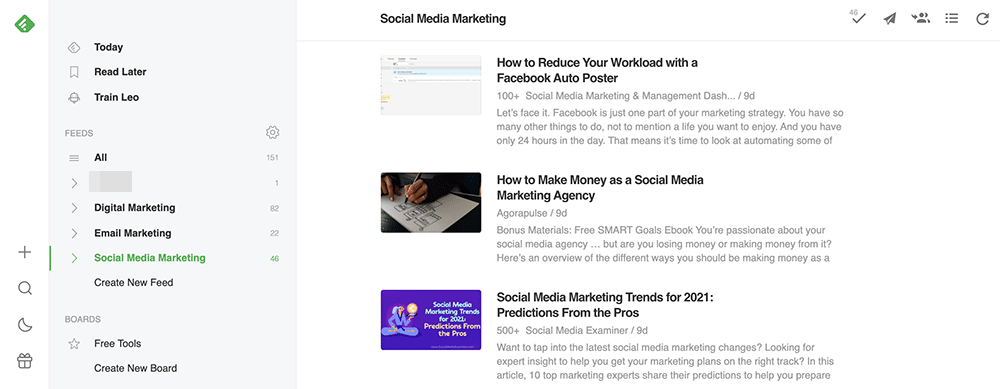
Keep on top of social media news.
To keep tabs on important blogs and industry sites, I recommend using a news aggregator app like Feedly.
Since you can set up themed feeds, you can easily monitor a variety of topics at once. I also recommend signing up for newsletters from Industry Dive, which collects the biggest headlines from the day or week.
Recap of the Daily Routine of a Social Media Manager
As a social media manager, your daily to-do list may change drastically depending on the campaigns you run and the clients you manage. With this sample schedule, you can create a framework to organize your day, avoid forgetting important tasks, and set your social media accounts up for success.
Get started on saving time and energy on your own social media management! Check out our free trial of Agorapulse to help you schedule, track, and measure all your social media efforts.






